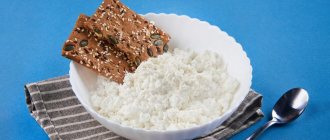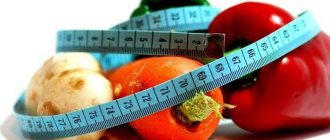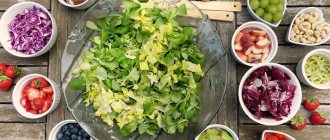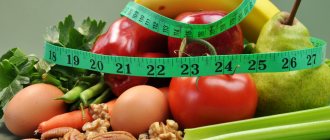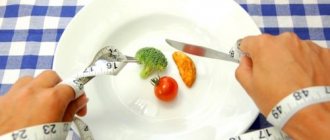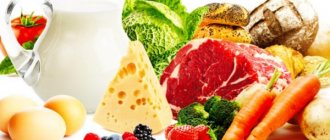The essence of a low-carb diet
Carbohydrates are a large group of chemical compounds, divided into simple (monosaccharides) and complex (polysaccharides). Each affects metabolic processes differently. Since they take an active part in most vital processes of the body, they cannot be completely abandoned. Therefore, with a hypocarbohydrate diet, the diet includes mainly slow carbohydrates, which take longer to convert into energy and do not contribute to the deposition of fat.
Advantages and disadvantages
Eating low in carbohydrates has a positive effect on overall health. It normalizes digestion, accelerates metabolism, and rejuvenates.
Pros of the diet:
- Does not cause feelings of hunger, weakness, loss of strength and other uncomfortable conditions.
- Ideal for diabetics.
- It does not harm the body, therefore it does not have a strict time frame.
- The lost weight does not return in the future.
- Recommended for all adults, regardless of lifestyle: active or passive.
- Does not require constant calorie counting.
When losing weight in this way, the hips are the first to shrink and the legs become slender, then the fat disappears from the sides and waist. Moreover, the buttocks and breasts acquire elasticity, which is actively promoted by protein.
This diet not only helps you lose weight, but also improves your health. It is indicated in the following cases:
- weight loss;
- intense sports activities;
- obesity;
- diabetes;
- hypertension;
- neurological disorders;
- endocrine disorders;
- cancer diseases.
It is especially used by athletes and bodybuilders, which allows them to quickly gain a sculpted figure without a share of fat.
Along with positive factors, there are also negative ones:
- the risk of developing serious diseases increases;
- the load on the liver increases;
- There is a deficiency of some microelements: potassium, sodium;
- contraindicated for people engaged in mental work on a daily basis;
- the concentration of cholesterol in the blood increases;
- visible results are observed only after 2–3 months.
Before starting a diet, it is recommended to first consult with your doctor.
Principles
The system implies the intake of a minimum amount of carbohydrates sufficient for the full functioning of the body. The usual daily intake for an adult of average build is 100 grams. For weight loss, the indicator is reduced to 40, in extreme cases - to 30 g. Carbohydrate consumption varies depending on gender: women need 2 grams per kilogram of weight, men - 3 g. Protein food will not only be a source of energy, but will also support muscle tissue in tone.
When on a low-carbohydrate diet, the distribution of nutritional components (BJU) is approximately as follows:
- carbohydrates - 30%;
- fat - 40%;
- proteins - 30%.
To obtain the desired results, adhere to certain principles:
- Avoid foods with a high glycemic index and high glucose content from the menu.
- Reduce the amount of salt, replacing it with lemon juice.
- Additionally, vitamin and mineral complexes are taken.
- Dishes are steamed or grilled, baked, boiled, stewed. Fry in a small amount of oil, and ideally without it at all.
- Eat at regular intervals, preferably at the same time. It is forbidden to skip meals.
- The main intake of complex carbohydrates falls in the first half of the day, and protein in the second.
- Have breakfast no later than an hour after waking up.
- Have dinner early so that you don’t eat anything else 3-4 hours before bedtime.
- Maintain water balance: drink up to 2 liters of clean water per day. Along with it, they drink still mineral water, herbal teas, coffee, chicory, and kefir.
Daily caloric intake should be kept between 1800–1900 kcal. To prevent muscles from atrophying, it is recommended to exercise additionally.
What you can eat and how much you need per day when losing weight
Of course, we cannot say that some carbohydrates are worse or better than others. In matters of nutrition, such evaluative categories are inappropriate. However, this does not stop many “fat monsters” from loudly declaring, “Look at the fitness bikinis, they mostly eat buckwheat and look cool, and plump homebodies eat sweets. The conclusion is obvious: buckwheat is better than sugar.”
Many people believe that the calories in sugar are more likely to contribute to weight gain than other carbohydrates. Others argue that all carbohydrates end up in the form of glucose in the body, so there's no point in trivializing: calories are calories.
But participants in this debate forget that products differ in their effect on metabolism and ease of absorption, macronutrient composition and the presence/absence of nutrients and nutrients.
It should also be noted that the vast majority of studies examining the effects of various carbohydrates on body composition are methodologically flawed. Many studies did not control for other macronutrient intake, such as protein or total energy intake, and followed an "eat as much as you want" approach.
And most of the research on sugar was conducted on rats.
Dopamine
Of course, to answer the question, “does the type of carbohydrate matter for weight loss?” What is needed are studies that compare groups of people whose diets are identical in every way except the source of carbohydrates, and then analyze whether there are differences in diet outcomes.
One way to differentiate carbohydrates is by dividing them into simple and complex. This classification depends on the chemical structure of the food and how quickly the sugar is digested and absorbed. Simple carbohydrates have a single or double chain structure. Complex carbohydrates have three or more structural compounds.
Please note that the division into simple and complex is completely arbitrary.
So, let's look at complex and simple carbohydrates with a list of healthy foods and a table for weight loss:
Simple and complex
Carbohydrates differ in their structure: complex ones consist of long molecular chains, unlike simple ones. However, it is important to note that at the end both groups break down to glucose.
Let's take a closer look at this process. All carbohydrates are made up of structural units called saccharides. The more of them, the more complex the carbohydrate. Simple carbohydrates are made up of one (monosaccharides) or two (disaccharides) of these units. Complex ones consist of three or more units.
Our intestines are capable of absorbing only monosaccharides. The job of the rest of the gastrointestinal tract is to break down the carbohydrate into its simplest form.
Thus, a simple carbohydrate does not need to be broken down, because it enters the body already prepared. And therefore it immediately enters the blood, sharply increasing insulin levels. It is quickly digested and does not give a feeling of fullness, which is why it is considered fast. Complex carbohydrates require processing, so sugar enters the blood gradually, and we get a long-lasting feeling of satiety.
There is an extremely erroneous opinion in which people believe that (quote): “the type of carbohydrates depends on the speed of digestion and absorption into the blood, accordingly, “simple” carbohydrates are digested quickly, and “complex” carbohydrates are digested slowly.” This is wrong!
We will discuss this myth below.
Fast and slow: a list of healthy foods and a table for weight loss
The concepts of “fast” and “slow” carbohydrates (sugars) are generally erroneous! This division was based on the expected time of absorption by the body. It was generally accepted that the absorption of glucose, a product of the breakdown of carbohydrates, takes a more or less long time, depending on the complexity of the carbohydrate molecule.
Since the mid-80s of the twentieth century, scientific studies began to be published confirming that such a classification is absolutely incorrect. Intestinal absorption of all carbohydrates occurs in the same period of time , approximately equal to 30 minutes, regardless of the complexity of their molecules.
Based on the classification of “fast” and “slow sugars,” nutritionists for a long time believed that “simple carbohydrates” (fruits, honey, lump sugar, granulated sugar), consisting of one or two molecules, are quickly and easily digested.
Since they do not require complex transformations, they can quickly turn into glucose, be absorbed by the intestinal walls and enter the blood. Therefore, these carbohydrates are called “fast absorption carbohydrates” or “fast sugars.”
And “complex carbohydrates” (cereals, legumes, tubers, root vegetables), the starch molecule of which consists of hundreds of glucose molecules, on the contrary, were believed to require longer exposure to digestive enzymes to break them down into individual glucose molecules.
It was assumed that this process takes quite a long time and the absorption of such glucose occurs slowly and gradually. This is why “complex carbohydrates” are called “slow absorption carbohydrates” or “slow sugars.”
This classification was developed purely theoretically . Decades later, after information had circulated through every conceivable channel (the media, nutritionists, the general public), some scientists, having doubts, decided to find out whether the long chain of starch that makes up complex carbohydrates actually takes longer to be absorbed in the small intestine.
It turned out that in the original theory, the rate of glucose entering the blood was mistakenly taken for the rate of release from the stomach , which actually differs for different carbohydrates.
Wahlquist's work confirms that peak glycemia occurs at approximately the same time for all types of carbohydrates , regardless of whether the composition of their molecule is complex or simple.
As the curve in the graph below shows, carbohydrates of any group (regardless of the complexity of their molecules), eaten separately and on an empty stomach, are absorbed in 25 - 30 minutes. Yes, the level will be different, but the time is the same ! It all depends not on time, but on the amount of glucose in the product!
That is why it is appropriate to consider that the time between the absorption of a carbohydrate and the peak of glycemia, which occurs at the moment of maximum absorption of the glucose obtained from it, is identical for all carbohydrates, be they complex or simple.
In his articles and speeches at dietetics congresses, Gerard Slama constantly calls on nutritionists to stop using a concept that does not correspond to any physiological reality.
Unfortunately, few people listen to him. Today, the vast majority of nutritionists, food industry enterprises and the media continue to refer to the hackneyed concepts of “slow” and “fast sugars”. Not to mention the sports field, where these “terms” are still an indisputable truth.
In fact, it is very difficult for most nutritionists to reconsider their views, much less bring their system into line with the results of new (well, new, after all, 30 years have passed) research. There is no doubt that it is for this reason that the general public often has the feeling that complete confusion reigns in the field of dietetics and nutrition.
But does it matter what type of carbohydrate we eat, simple or complex, for our figure?
In a 6-month study of 390 participants, one group ate foods high in complex carbohydrates and the other group ate foods high in simple carbohydrates.
Both diets contain the same amount of calories and carbohydrates in total.
At the end of the experiment, it was found that there were no differences in fat loss or muscle retention. The diets were also identical in their effects on blood lipid levels. In support of these findings, other studies have shown that diets with different sugar contents led to the same changes in body composition.
In another type of study, replacing some complex carbohydrates with simple carbohydrates did not lead to any changes in body composition. A recent meta-review of the literature on the effects of fructose on body weight concluded that replacing fructose with other carbohydrates for the same caloric value does not cause weight gain.
Thus, for weight loss/maintenance/gain, it does not matter which carbohydrates in your diet are simple or complex, as long as the total amount of kcal and macronutrient basket is the same .
Why I'm not losing weight: 5 most likely reasons
Low carb diet: foods
Products for a low-carbohydrate diet should be high in protein and low in carbohydrates and fat.
Among meat products, you can give preference to chicken, turkey, duck, lean beef and lamb. Pork has a high fat content, so it should be excluded during the diet. You should also exclude canned and smoked meat and meat products such as sausages, sausages, and sausages. There are practically no useful or nutritious substances in them.
Fish and seafood are also a source of high-quality protein. The protein contained in fish, unlike “meat” protein, is more easily absorbed by the body and contains all the necessary amino acids. Proteins should be consumed with other healthy foods at every meal. These are mainly vegetables. Include tomatoes, cabbage, and cucumbers in your diet. It is advisable to eat vegetables fresh, without subjecting them to heat treatment. This way they will provide the maximum amount of vitamins and minerals the body needs during a low-carb diet.
You should exclude starchy vegetables such as potatoes, beets, radishes.
Products for a low-carb diet include dairy products, for example, kefir, low-fat cottage cheese, yogurt with up to 3% fat and milk. They are best combined with unsweetened fruits, but it is not recommended to combine them with meat. Soft and hard cheese contains at least 5% protein and therefore should be included in a low-carbohydrate diet. The protein contained in eggs is ideal for nutrition, but you should not overdo it and eat more than 3 eggs per week.
Why product compatibility is important
Sometimes after eating we have a desire to sleep.
This happens because digestion requires a colossal amount of energy from all body functions. The work of the heart, lungs, nerves, brain, endocrine glands, all organs and systems constantly requires a certain amount of energy. Digestion takes more energy from the body than all its functions and any physical activity (running, cycling, etc.). Where can the body get additional energy from? Obviously there are only two ways.
- Eat easily digestible food, on which the body spends the least amount of energy and time to digest, assimilate and cleanse it.
- Combine products correctly.
Each product has a specific chemical composition, which determines its digestibility in the human body. All products are divided into quickly and slowly digested.
If you eat food with different “speeds” of digestion, there will be a delay in the body of fast foods.
Be sure to read:
What foods contain folic acid: list, table with values, how it affects weight loss
Also, each food group requires its own environment in the stomach. For example, for chicken meat it should be acidic, and for mashed potatoes it should be alkaline.
Carbohydrate foods are best combined with fats, vegetables, and herbs. This combination is safe for the body and does not lead to food fermentation.
Scientist William Hay proved that when simultaneous consumption of protein foods and carbohydrate foods, the alkaline environment interacts with the acidic one, as a result of which they neutralize each other.
With this process, 40% of the food remains undigested.
Separate nutrition will greatly simplify the functioning of the human body and improve health.
Nutritionists have identified several groups of incompatible foods:
- Foods high in protein and flour products.
- Proteins of plant origin and proteins of animal origin.
- Pastries and fruits.
- Flour products and dairy products.
- Proteins and milk.
Thus, tea cannot be combined with milk, since the proteins contained in milk prevent the absorption of the beneficial properties of tea.
Avoid combining cheese with meat.
What carbohydrates should you eat?
Your diet should include carbohydrates with a low glycemic index. Because foods with a high GI (glycemic index) can quickly increase blood sugar levels, and we absolutely cannot do this. As for the opposite side, foods with low GI gradually increase blood sugar levels, due to which there is no excess glucose in the body and fat is not deposited. Below are special images for a clear and understandable picture:
As for protein foods, try to add foods to your diet that contain a small percentage of fat. The optimal list would be something like this:
Variation of a low-carb diet with carbohydrate alternations
A low carb diet with carb cycling is a very powerful tool. The key is carb days. Those. First we have protein days - this is when we eat up to 4-5 meals with virtually no carbohydrates (with the exception of breakfast, no less than 20 and no more than 60 grams of carbohydrates). Subsequent meals consist exclusively of protein foods with the addition of greens or salads. Such days (no more than 3 in a row) should be alternated with carbohydrate days, when the proportion of protein is minimal (less than 1 gram per 1 kg of weight), we get pure carbohydrate days with complex carbohydrates. These can be different types of porridges, with the addition of vegetables that are rich in fiber. With this diet, your body will use up subcutaneous fat well. Also, don’t forget to add plenty of water and exercise to all this.
Basic principles of a low-carb diet:
1- Gradual. Try to gradually reduce your carbohydrate intake. Because it is the gradual reduction of carbohydrates that will protect you from unnecessary problems and disruptions in your body.
2- Fasting days. Don’t forget about fasting days, and give your body such short-term “respites”.
3- Proteins. If you cut back on carbohydrates, replace them with higher amounts of protein. The main ones are: meat, fish, milk, eggs and some vegetables. Keep your intake to at least 3-4 grams of protein and no more than 5-6 grams of protein per 1 kilogram of your own dry body mass.
4- Carbohydrates. Carbohydrates must be present in your diet, but in minimal quantities, for the functioning of the whole organism. The optimal carbohydrate intake for a low-carbohydrate diet is considered to be 0.8 grams of complex carbohydrates per 1 kg of body weight.
5- Fats. You don’t need to completely exclude them; they should be present in your diet, but with one amendment, or rather, two. 1- Avoid bad fats (saturated and trans fats, and cholesterol) in your diet. 2-consume only healthy fats in limited quantities. If we take an average calculation, the amount of fat consumed should not exceed 30 grams per day.
6- Vegetables. Give preference to those vegetables that contain a small percentage of starch.
7- Water. Remember that coffee and tea can remove water from the body (thanks to caffeine), so you are not compensating for anything by drinking a cup of tea or coffee. Water is your main “drink” at any time, consume at least 2 liters. per day (depending on body weight).
8- Division of techniques. Break all your meals into 4-7 servings.
9- Combination. Each of your meat dishes should be accompanied by herbs or vitamin C.
The biggest disadvantage in almost any protein diet is the lack of balance (BJU, vitamins and minerals, fiber and even water). Ultimately, important organs suffer: liver, kidneys, etc. An excess of protein shifts the acid-base balance of our body to the acidic side. If you eat a lot of protein, then vegetables and greens must be present in your diet. It is best to lose weight with plenty of complex carbohydrates and fruits, because... the body will receive all the necessary macro and micronutrients. Therefore, we can safely conclude: competent weight loss is a smooth weight loss, without a deficiency of all necessary nutrients.
What foods do not contain carbohydrates?
In its original form, meat does not contain any carbohydrates.
Food products that do not contain carbohydrates are not a myth. Such food really exists and is the key to an effective diet and a healthy body.
In its original form, meat does not contain any carbohydrates. They are formed during the cooking process due to the addition of sauce or spices. The same applies to sausages. Before purchasing them, carefully study the composition.
List of products that do not contain an energy source:
- chicken, beef, venison, pork, duck;
- shrimp, oysters, mussels, crabs;
- salmon, halibut, trout, catfish;
- butter, Guyère cheese;
- spinach, radishes, cucumbers, cabbage.
- fish oil, table salt.
Carbohydrates are found in small quantities in zucchini (7 g), cauliflower (5 g), champignons (2 g), cherry tomatoes (6 g), celery (1 g), tofu (3 g).
Why do buns make you fat?
The menu for a carbohydrate-free diet must be drawn up with an understanding of the nature of these “terrible” substances. There are simple and complex carbohydrates - useful and harmful when losing weight.
Video on the topic
Konstantin Monastyrsky will talk about dangerous carbohydrates
Dangerous carbohydrates
The human body digests simple carbohydrates without much effort and quickly accumulates them on the sides. Such substances provoke an increase in blood sugar levels and increase appetite. Therefore, tables with low carbohydrate content are suitable for diabetics.
Potatoes, pasta, some alcoholic drinks, sugar, desserts and sweet fruits are carriers of fast carbohydrates.
Healthy carbohydrates
But complex carbohydrates, on the contrary, will force the body to work harder. In order for plant fiber, vegetables and berries to be absorbed, it takes time and significant energy costs. In this case, carbohydrates do not harm the figure, manage to fulfill their beneficial role and provide a long-term feeling of fullness. In addition, such products stimulate intestinal motility. And normal metabolism is the key to healthy weight.
According to doctors, if you decide to lose weight without carbohydrates, then it is safest to reduce only fast organic substances, and consume carbohydrates from fiber and vegetables without restrictions.
List of foods with simple and complex carbohydrates
| Products are "good" | Products are "bad" |
| Fresh juice | Concentrated juice |
| Bananas | Candies |
| Milk | Soda |
| Apples | Cookies and Cakes |
| Refined (“bad”) | Unrefined (“good”) |
| French fries | Cereals (lentils, chickpeas, black beans) |
| White bread | Vegetables (pumpkin and carrots) |
| Pasta (white flour) | Brown rice |
| White rice | Pasta made from whole grain flour |
Diet without carbohydrates - what you can eat and what you should eat
Nutritionists highlight foods that need to be excluded completely and without regard. Of course, these are the same “fast” carbohydrates.
Strictly speaking, some categories of these products should not be consumed outside of the diet, at normal times:
- Sweet soda, juices and juice drinks with high sugar content.
- Fast food, semi-finished products.
- Sweet pastries, confectionery.
- Bakery products.
During the diet, you should not eat a lot of fruits and berries, giving preference to vegetables, legumes and whole grain cereals. The required amount of carbohydrates per day is about 100 grams.
The rest of the food is proteins:
- Meat and poultry.
- Fish and seafood.
- Dairy products.
- Eggs.
- Water, tea or coffee without sugar.
You should remember the need to reduce the amount of fat in your diet. When choosing meat, you should give preference to beef over pork, and try to use only breast when choosing chicken. During the diet, you cannot eat fatty fish (halibut, catfish), and you can only eat protein in eggs. But you shouldn’t completely exclude fats either - this is harmful to the beauty of your skin and hair. Experts advise maintaining optimal fat levels by drinking one or two tablespoons of vegetable oil.
Another important nuance of low-carbohydrate nutrition is rapid intoxication of the body.
To prevent the process of losing weight from ruining your health, it is important to monitor the amount of water consumed. How much fluid should you drink? Provided that it is not tea or coffee, but clean water - at least 2 liters per day
Diet without carbohydrates: menu for the week
When drawing up a sample menu for the week, you should adhere to the following proportions of products for each meal:
Breakfast
- Rabbit or veal, 150 grams. Garnish – green peas. Tea without sugar.
- Low-fat cottage cheese, 150 grams, coffee without sugar.
- Whites of 2 eggs, fermented baked milk – 200 ml.
Lunches
- Hake or cod – 200 grams, grapefruit or apple.
- Beef or rabbit – 150 grams, tomatoes.
- Boiled chicken breast – 200 grams, carrots.
Dinners
- Navaga or pollock – 150 grams, boiled beet salad with vegetable oil.
- Cottage cheese with low-fat yogurt dressing – 150 grams.
- 4 egg omelette, beans or lentils.
In between meals, it is allowed to eat unsweetened and low-fat snacks, for which grapefruit, cottage cheese or fermented baked milk can be included in the menu.
Restricted Carbohydrate Diet: Pros and Cons
Why does low-carb weight loss top the popularity charts?
- You don’t have to limit yourself to eating delicious dishes and products (except for those that are prohibited).
- Losing weight by including more protein foods in your menu allows you to eat without feeling hungry.
- Such diets maximally comply with the principles of healthy nutrition, controlling the balance of proteins, fats and carbohydrates in the body.
However, such weight loss programs are not without negative factors:
- Experts recognize the balance of nutrients as insufficient due to the absence of some carbohydrate-containing products on the menu.
- In the absence of supervision by a specialist, disturbances in water and electrolyte balance and problems with the endocrine system are possible.
- A diet without carbohydrates has a number of contraindications.
Contraindications
When applying any diet, you should remember the principle of “do no harm.” The main goal of a weight loss program is not only to reduce weight, but also to benefit the body. Losing weight at any cost will never give the desired result, but will only completely ruin the metabolism and the functioning of internal organs. As a result, the hated fats will not only return instantly, but will hardly want to leave the unfortunate body again.
That is why, before going on a diet, you should consult with an experienced specialist and check your health. A low-carbohydrate diet involves a sharp increase in protein in the diet, which increases the load on the kidneys and intestines. It is contraindicated for people with problems of the urinary and digestive systems, as well as for those who have recently undergone surgery.
It is also worth thinking about the discomfort that a change in diet brings - at first, the diet may be accompanied by constipation. And lastly, no diets are allowed for minor girls, as well as pregnant and nursing mothers.
It is also important to remember how long the diet should last. Those who can use it without restrictions should not abuse the timing - a low carbohydrate content in the diet is permissible for a period of no more than 4-5 weeks
Diet with limited digestible carbohydrates
The basic principles of such a diet include the following recommendations:
- Eating enough food containing proteins and fats. These products include eggs, lean meats and fish, nuts, sunflower seeds, whole milk, and dairy products.
- Maintaining insulin production. To do this, the amount of carbohydrates consumed must be at least 1 g/kg of a person’s weight.
- Reducing the amount of simple carbohydrates. Easily digestible foods are included in the diet in minimal quantities. In this case, you need to take into account the glycemic index of foods. It is better to exclude confectionery products from the menu.
- Compliance with diet. Food is taken 5-7 times a day in small portions. Breaks should be no more than 4 hours. Otherwise, protein deficiency develops, which contributes to rapid weight gain.
- Compliance with food preparation rules. Products need to be steamed, boiled or baked. Vegetables are good to eat fresh. Smoked, fried and pickled products, and baked goods should be avoided.
In nutrition, the degree of harm or benefit cannot be assessed unambiguously. Even in the composition of dishes that do not belong to a healthy diet, there are components necessary for human life. This especially applies to fast carbohydrates.
In this matter, the quantitative indicator is much more important.
However, one should not discount the quality of food containing easily digestible carbohydrates; the list of products that must be minimized in the diet is presented by the following items:
- bakery;
- confectionery;
- sugar;
- ready-made sauces;
- sweet drinks.
However, moderate consumption of baked goods made from whole grain flour will not harm your figure. For people who are on a diet, honey is an excellent substitute for sugar. They can be used to sweeten some drinks in small quantities.
It is better to consume products that are classified as simple carbohydrates in the first half of the day. And if you want to eat sweets, it is much healthier to eat fruit. The sweet delicacy is allowed to be consumed in a single quantity until 16:00.
A diet with a restriction of easily digestible carbohydrates provides for a certain daily intake, which should not exceed 30% of the total amount of carbohydrates in the diet. To be precise, this figure is close to 50 grams. It is necessary to adhere to the norm; a decrease in the given indicator is dangerous for health and can lead to deterioration of well-being.
If you make it a rule to eat all allowed sweets before lunch, this will reduce the risk of a breakdown. Such a diet will help you switch to proper nutrition without much discomfort and not completely deny yourself from eating your favorite foods. For this, your body will thank you with excellent health and a slim figure.
Today, nutritionists are increasingly talking about the compatibility of foods, since it is their harmonious combination that is an indicator of health, a slim figure and a good mood. In this case, what is the food compatibility system?!
In the modern world, in the world of stress, in the world of chronic fatigue, lack of sleep, food compatibility is indeed important for the healthy functioning of the whole body, as well as for it to receive all the necessary vitamins, microelements and nutrients, as well as for the prevention of a number of diseases .
A diet limiting easily digestible carbohydrates implies the normalization of healthy body activity and further weight control. Nutritionists have developed a special diet plan based on reducing carbohydrate intake. As a result, the body begins to produce energy through the slow oxidation of fats and amino acids. Such a diet allows you to get back into shape in a short time.
The emphasis is on foods rich in fats and proteins. These include:
- meat;
- eggs;
- seafood, fish;
- milk products;
- seeds, nuts.
The source of microelements can be:
- grain crops;
- peas;
- corn;
- potato;
- oat groats.
Main meals are distributed at intervals of 2–3 hours. Portions should be small.
Completely avoid smoked and fried foods. Preference is given to boiled, baked, steamed dishes.
In addition to a balanced diet, you should lead an active lifestyle: physical activity is required 3-4 times a week for at least 30 minutes. Excessive overexertion is contraindicated for people with low blood sugar.
In a month, in this mode, all metabolic processes are completely restored, without the appearance of unnecessary deposits. If insulin production is normal, it is recommended to follow a similar diet at least once a year, which improves well-being and promotes weight loss.
An indicative menu for weight loss is presented in the table.
| Days | Breakfast | Snack | Dinner | Dinner |
| 1 | Omelette with mushrooms, green onions and tomatoes. Coffee or tea without sugar | Green apple. Lettuce, with a small amount of olive oil, low-fat cottage cheese | 300 grams of boiled meat, fresh cucumber and tomato salad | Fish baked in foil |
| 2 | Cottage cheese (200 grams), half an apple and any unsweetened drink | Salad with flaxseed oil dressing | Meat salad with herbs and lemon dressing | Vegetable soup |
| 3 | Boiled eggs, hard cheese, unsweetened tea | Seafood salad, grapefruit juice | Broccoli or mushroom soup, pork chop | Squid stuffed with boiled carrots, yogurt with berries or fruits |
A diet that excludes or limits easily digestible carbohydrates is designed to reduce weight and normalize the functioning of the body. During such a diet, the body receives energy from oxidized fats and amino acids.
A diet with the exclusion or limitation of easily digestible carbohydrates is designed to reduce weight and normalize the functioning of the body
To maintain insulin levels, the amount of carbohydrates required is calculated from the ratio of 1 g per 1 kg of body weight. In this case, it is advisable to consume complex carbohydrate compounds.
The duration of the diet is 30 days, after which you need to take a break.
The following foods should be included in your diet:
- boiled meat;
- boiled eggs;
- varieties of fish rich in fats;
- nuts;
- cottage cheese;
- Brown rice.
These products should become the main components of the diet menu.
Example 1:
- Breakfast: omelette with tomatoes, coffee or tea without sugar.
- Snack: lettuce, apple, low-fat cottage cheese (mix these ingredients and add 1 teaspoon of olive oil to get a delicious dish).
- Lunch: 250-300 g of boiled chicken fillet, fresh cucumber and tomato.
- Dinner: fish baked in foil.
Be sure to read:
Vegetable fats: list of products, composition and calorie content, categories, does it affect weight gain
Example 2:
- Breakfast: 200 g of cottage cheese, 0.5 apples, unsweetened tea (coffee).
- Snack: fresh vegetable salad with flaxseed or olive oil dressing.
- Lunch: salad with meat, seasoned with lemon juice.
- Dinner: vegetable soup.
Example 3:
- Breakfast: 2 boiled eggs, a slice of hard cheese, coffee without sugar.
- Snack: seafood, a glass of freshly squeezed grapefruit juice.
- Lunch: broccoli soup, steamed pork.
- Dinner: stuffed squid, yogurt.
There should be a time interval of 2-3 hours between meals, and the portions should not be large. The consumption of smoked and fried foods is not allowed.
During the day you need to drink at least 2 liters of clean water. After 14 days, arrange a “holiday menu”. On this day, eat the foods you want, but you shouldn’t abuse them.
How and what to cook
So, you have a low-carbohydrate diet ahead - recipes for such nutrition can be quite varied and interesting. There are a lot of options for cooking meat and fish, especially oil and spices are not excluded. In the morning, treat yourself to omelets with cheese or permitted vegetables and herbs. If you're in a hurry, breakfast is a couple of eggs plus coffee.
Diet fans come up with a lot of original recipes. Such culinary inventions include mitza (from the English meat (meat) + pizza (pizza). The highlight is that instead of dough, minced meat is used, well compacted on a sheet (or in a baking dish). For the filling - mushrooms, allowed vegetables and hard cheese.
Frequent meals are another point that a low-carbohydrate diet suggests: the weekly menu is based on the principle of 5-6 meals a day. Each time on your plate there should be about 300 grams of meat (fish, poultry, offal) + about 150 grams of vegetables or herbs. You can cook soups, but without potatoes. For dessert - citrus fruits or a handful of cranberries.
The essence and features of the diet
The essence of a low-carb diet is to eliminate starch and sugar from the diet. This ban applies to all food products that contain these substances. By giving up these types of carbohydrates, you can not only lose weight, but also improve your well-being.
Although sugar is a simple carbohydrate that is quickly digested and does not benefit the body, starch is complex and requires more time to process, but it is also “empty” of benefit for the body. Once in the body, they are sent to the pancreas, whose enzymes quickly “digest” them into glucose and release it into the blood.
Maintaining Glucose Levels
To avoid such a “bouquet” of diseases, you need to maintain normal glucose levels. To do this, you need to reduce the amount of healthy carbohydrates consumed per day. This is not difficult, since complex or regular carbohydrates are present in small quantities in meat, fish and other foods. You just need to combine the ingredients of the dishes correctly. And forget about sweets.
Many nutritionists consider a low-carbohydrate diet, like, for example, intermittent fasting or fasting days, not a short-term weight loss system, but a nutritional system that is applicable for some diseases and can be used as a basis for creating a menu. Her diet mostly consists of protein foods and fiber. From these products you can easily prepare dishes and drinks with a minimum amount of carbohydrates, rich in proteins, which are used by athletes to burn fat and saturate the body with nutrients.
Reducing carbohydrates
Although carbohydrates are among the “building” elements of the body, exceeding their quantity is harmful to human health. Therefore, this diet is aimed at reducing carbohydrates in the diet. Reducing the level of carbohydrates consumed provokes the body to waste accumulated energy in the form of fat deposits on the body and internal organs.
Low-carbohydrate eating differs from high-protein diets in that you don't have to fast, eat small portions, or munch on undressed salads or bland dishes. Here it is allowed to use spices, salt or soy sauce, and vegetable oil in moderation. And what may please many gourmets is that some dishes allow frying of foods.
Types of carbohydrates
A person can obtain carbohydrates exclusively through food. They are found in a variety of foods and fall into two categories:
- easily digestible carbohydrates;
- difficult to digest.
The difference lies in the rate of breakdown and further transition to glucose. In other words, food that takes longer to digest provides a feeling of fullness for a longer period of time. Such carbohydrates are more useful. In order to find out which foods are easily digestible carbohydrates, you need to pay attention to only one factor.
To calculate the rate of breakdown, the glycemic index (GI) was introduced.
- Provided that the indicator does not exceed 70, the product is classified as slow carbohydrates. They are found in most vegetables, beans and grains.
- If the GI value exceeds the specified mark, then we have products containing easily digestible carbohydrates. Such food is not able to eliminate the feeling of hunger for a long time. As a result, the absorption process is disrupted, as a result, excess is stored in reserve, “bad” cholesterol accumulates in the body, and the pancreas suffers from overload.
However, it is not recommended to completely exclude easily digestible carbohydrates from the diet. This diet is not suitable for everyone. For example, for those who prefer an active lifestyle and play sports professionally, these substances are very useful. After training or active activities, muscles need glycogen, which needs to be obtained as quickly as possible. Therefore, for proper recovery of the body after exercise, it is very important to know what constitutes easily digestible carbohydrates.
Disadvantages of a Low Carb Diet
The following consequences of switching to this diet can be considered harmful:
Fat burns in the flames of carbohydrates
In order for fat to be burned, it must go through a metabolic process within the mitochondria in the muscles. During aerobic fat metabolism, several processes must occur.
The product of carbohydrate metabolism (oxaloacetate) acts as the source of this metabolic reaction. It is clear that the decrease in glycogen levels that occurs with a low-carb diet will affect oxaloacetate levels and therefore the metabolic process of fat utilization.
Reducing training intensity
A low-carb diet lowers glycogen levels because the body switches to ketones for energy. Obviously, lower glycogen levels will significantly impact physical performance in the gym. Reduced glycogen levels will reduce the amount of effort you can perform during both strength and cardiovascular training.
The reduced workload during strength training means less muscle fiber work and wasting, and therefore less visible muscle growth or shrinkage if you're on a strict diet.
Reducing the workload during cardiovascular exercise will reduce the total number of calories burned and, therefore, fat.
Many reviews of low-carb diets suggest research showing that declines in physical performance are ignored because this is the time the body uses to switch to fat metabolism. But it's still ambiguous.
Reduced fiber and microelements
A low-carb diet suggests eliminating most sources of fiber, since fiber/NSP (non-starch polysaccharide) sources are also high in carbohydrates. At the same time, there may be a decrease in micronutrients (vitamins and minerals), since the most fibrous sources of carbohydrates also provide the lion's share of micronutrients.
Given that most vitamins act as coenzymes for many body functions, including energy metabolism and cell construction, it is obvious that a decrease in micronutrient levels will impede physical development.
Hypoglycemia and low testosterone levels
Although fat and cholesterol are vital nutrients in the production of anabolic hormones such as testosterone, a state of chronic hypoglycemia due to severe carbohydrate restriction has been shown to reduce the amount of luteinizing hormone and therefore reduce testosterone levels. Clearly, decreased testosterone levels will impact adaptive responses to training.
Low glycogen levels cause the body to try to get energy elsewhere, namely from fat and muscle. As glycogen levels drop, an enzyme is produced that breaks down branched chain amino acids from muscles for use as energy.
With this in mind, a low-carb diet will constantly keep you in a state of catabolism, where the body tries to use other fuels instead of the glucose that is normally stored and circulated.
Slow carbohydrates
At one time it was popular to go on low-carb diets. Of course, this method yielded results quite quickly. But in order for weight loss to occur without negative health consequences, you simply must consume carbohydrates, and slow ones. They are also called complex.
The advantage of complex carbohydrates is their slow absorption by the body. This means that the process of digestion (saturation) proceeds so slowly that insulin production occurs at a moderate pace, which allows you to maintain a feeling of fullness for a very long time. In addition, slow absorption reduces the risk of converting carbohydrates into fat. As you know, fast or simple carbohydrates are broken down very quickly - this gives a sharp release of insulin and high blood sugar levels. This effect is fraught with stress on the pancreas and the formation of excess fat.
Examples of slow and fast carbohydrates
Below you can find a small list of complex and simple carbohydrates. This short list of foods will give you some insight into how to choose your carbohydrate diet.
Slow
- Brown (brown rice)
- Whole wheat bread
- Bran
- Durum wheat pasta
- Oatmeal
- Cereals
- Legumes
- Dark chocolate (more than 85% cocoa)
Fast
- Sugar
- White rice
- Semolina
- Carrot
- White bread
- Banana
- Grape
- Honey
- Alcohol
Nobody says that you need to give up fast carbohydrates, just when losing weight, their amount should be reduced to a minimum. Even after you lose weight, do not stop monitoring your intake of fast (simple) carbohydrates.
Time to consume slow carbohydrates
It is important to pay attention to the timing of consumption of complex carbohydrates. On days of active training, they can be consumed in sufficient quantities.
On rest days, it is necessary to focus on the first half of the day, because... in the evening you no longer need much energy. Keep in mind that exceeding the amount of any carbohydrates in the daily diet leads to the formation of excess fat tissue.
Complex carbohydrates with proteins and carbohydrates
There is such a thing as the balance of fats, proteins and carbohydrates. Combining carbohydrates and fats is highly not recommended. The body will not find room for such a “cocktail” and will store the excess as fat. But the combination of carbohydrates and proteins will provide the body with nutrients and energy without compromising your figure.
Remember that slow carbohydrates are for energy, brain nutrition, metabolism, muscle recovery after workouts and weight loss.
What is a gainer for?
Fat Burning Diet
What burns fat in the body
How to fight hunger
Daily protein intake
10 Tips for Burning Fat
Low-carbohydrate diet list of products in the weekly menu
If you decide to get hooked on such weight loss, this does not mean that you cannot eat anything on a low-carbohydrate diet other than the list of foods listed above.
In it, I gave examples of what must be abandoned, and where the squirrel is - even scoop it up with a ladle. As proof, the menu is below.
You can replace regular potatoes with sweet potatoes
Monday
Breakfast - carrot and orange smoothie with the addition of sprouted wheat grains
Lunch - lentil or pea soup, a serving of quinoa with fried seitan, green tea or sugar-free fruit drink
Snack - a handful of nuts
Dinner - cottage cheese with herbs, a glass of low-fat yogurt
Nutritious smoothie - a great solution for breakfast
Tuesday
Breakfast - oatmeal with water, smoothie based on yogurt and berries
Lunch - vegetable soup with broccoli, tempeh sauce, unsweetened tea or dried fruit compote
Snack – two apples
Dinner - salad with chickpeas and vegetables, a portion of buckwheat porridge, tea
Vegetable soup with broccoli
Wednesday
Breakfast - pearl barley porridge and smoothie with pumpkin
Lunch - dal soup (recipe can be found here), some hummus or avocado toast, juice or tea
Snack - a glass of kefir
Dinner - tofu with stewed vegetables, tea
Tofu with stewed vegetables
Thursday
Breakfast - sandwich with cheese and avocado, glass of juice
Lunch - chickpea soup, pinto bean puree and a couple of diet breads
Snack - a handful of nuts
Dinner - boiled broccoli salad with feta cheese, tea
Diversify your menu with avocado sandwiches
Friday
Breakfast - yogurt smoothie with berries, banana and oatmeal
Lunch – pumpkin puree soup and a portion of lobio
Snack - a portion of low-fat cottage cheese with berries
Dinner - flaxseed porridge and a glass of sour milk
Pumpkin puree soup
Saturday
Breakfast - oatmeal with dried fruits, coffee without sugar
Lunch - bean soup, a portion of stewed asparagus, dried fruit compote without sugar
Snack: low-fat yogurt
Dinner - a portion of brown rice with corn and tea
Asparagus also contains a lot of protein
Sunday - we give ourselves the right to relax and eat as usual (of course, without throwing everything into ourselves indiscriminately), so that on Monday we can return to our routine with a light heart.
As you can see, in a low-carbohydrate diet, a grocery list for a week allows you to eat varied, because food should not only be healthy, but also pleasing to the taste buds.
The founder of separate meals, Herbert Shelton, wrote that you need to sit down at the table when you want, and always in a good mood.
If you're not yet familiar with vegetarianism, at least three of the dishes in the diet I presented should have raised questions in your mind: pinto bean puree, fried seitan, and tempeh sauce.
I'll tell you what it is and how to prepare it all.
Tempeh sauce
Tempeh is a very dense soybean cake that vegetarian cooks use as a meat substitute for its nutty, meaty flavor.
Protein in it is 19% of 100 grams of weight.
That is, there is no way in our diet without it. The sauce from the recipe below will not only fill you with protein, but will also pleasantly surprise you with its taste.
Tempe
Divide one block of tempeh into pieces and fry in oil until golden brown.
Add finely chopped onion, bell pepper and a few cloves of garlic.
Half a teaspoon of cumin and 2 tablespoons of soy sauce are suitable as seasonings.
Finally, add a large can of tomato paste (400g) into the pan and turn it off when it boils. Add salt, pepper and chili to taste.
This sauce can be stored in the refrigerator for a long time.
Tempeh sauce
Fried seitan
Seitan is a wheat protein that we used to call gluten (those who are naturally gluten intolerant should not eat it).
It was born in the vastness of Asian cuisine, from which it came to us to replace meat for vegetarians. 100 grams - 25% protein.
Fried seitan
Boil the seitan and cut into strips.
In a multicooker bowl, heat a minimum amount of oil and add spices: half a teaspoon of ground pepper, turmeric and asafoetida, a teaspoon of paprika and a pinch of nutmeg.
Add 3 tablespoons of soy sauce there and fry the seitan for about seven minutes, turning occasionally.
Pinto bean puree
Why Pinto? Because 21% protein per 100g.
Bean puree will be both a healthy and satisfying lunch while losing weight. By the way, this type of legume is especially popular in Mexico, where they love everything spicy and hot.
Bean puree
When the beans are cooked and soft, puree them in a blender with a small piece of butter.
Svan salt and suneli hops are suitable as spices.
Lose weight correctly and stay with Life Reactor!
Where can you get easily digestible carbohydrates?
Of course, slow carbohydrates bring much more benefits to the body. In fact, most of humanity’s favorite dishes are not the most correct and healthy. These are the same easily digestible carbohydrates; a list of foods and a table of foods with the indicated GI in which they are contained are given below.
These include:
- alcohol;
- confectionery;
- bakery;
- ketchup;
- pure sugar;
- sweet drinks;
- honey;
- mayonnaise
- sugar-containing dairy products;
- starchy vegetables;
- some fruits.
When considering easily digestible carbohydrates, the list of which is given above, it is necessary to delve into the essence of the issue in more detail. After all, they include a huge list of delicacies. To do this, consider a table of GI indicators for the most popular food products included in the diet of almost every inhabitant of the planet.
Easily digestible carbohydrates, table:
| Product name | GI | Product name | GI | Product name | GI |
| Cornflakes | 85 | Fried potatoes | 95 | Beer | 110 |
| White bread | 92 | Lasagna | 75 | Honey | 90 |
| Corn porridge | 70 | Muesli | 80 | Rice | 90 |
| Mashed potatoes | 82 | Donuts | 75 | Popcorn without sugar | 85 |
| Zucchini caviar | 75 | Grape | 75 | Pumpkin | 75 |
| Waffles | 75 | Biscuit | 70 | Rice porridge with milk | 75 |
| Watermelon | 72 | Boiled carrots | 85 | Carbonated drinks | 75 |
| Baguette | 70 | Puffed rice | 75 | Turnip | 85 |
| Dried fruits | 75 | Chips | 85 | Bagels | 75 |
| Milk chocolate | 71 | Puff pastry pastries | 100 | Dates | 146 |
| Lollipops and caramel | 80 | Ice cream | 79 | Canned corn | 78 |
| Ready juices | 74 | Banana | 70 | Halva | 70 |
| Pancakes | 70 | Milk, condensed with sugar | 80 | Bread | 70 |
| Jam | 71 | Pizza | 86 | Hot Dog | 90 |
| Canned fruits | From 80 | Swede | 99 | Shortbread | 105 |
This is how large a portion of the diet is occupied by easily digestible carbohydrates; the products listed in the table most contain many useful substances. Therefore, there is no reason to deprive the body of goodies; it is enough just to follow a certain diet with restrictions.
The right way out
Despite the effectiveness and simplicity of the low-carb method, it is recommended to take a break after 2 months from the start of its implementation. The exit must be consistent so as not to provoke stress in the body. Do not immediately switch to foods rich in carbohydrates. Otherwise, the lost kilograms will return.
The algorithm for transitioning to a normal diet lasts about 3–4 weeks and is as follows:
- During the first 2 weeks, the ratio of BZHU does not undergo drastic changes. The basis remains proteins with a small amount of fat.
- Increase the portion of non-starchy fruits daily.
- In the third week, the amount of protein consumed is reduced by introducing cereals.
- The number of calories is increased little by little every day. The most high-calorie meals are consumed in the first half of the day.
They still eat in small portions, several times a day.
Experts' opinions
The results of the diet are quite impressive
That is why in the 2000s they began to pay close attention to its study. Research was aimed at studying the reason for this effectiveness, bordering on miraculousness.
Of course, there were opponents who directly stated the harm that a low-carb diet brings. Reviews and results refuting this opinion, unfortunately, were not taken into account at all.
The main complaints were:
- increased cholesterol levels;
- the risk of developing cardiovascular diseases, which can be caused by an increased protein content.
There are also directly opposite opinions. For example, the Association of American Family Physicians confirmed the effectiveness of the diet by recording its recommendation in an official letter.
However, despite all its effectiveness, a low-carb diet is not suitable for everyone. That is why, before starting to draw up a menu, it is worth discussing this issue with your doctor. Even an absolutely healthy person, due to a nutritional imbalance, needs to start taking vitamins and minerals, the correct choice of which will be helped by a doctor. This method of losing weight is completely unsuitable for athletes, nursing mothers and pregnant women.
For people with kidney disease or gallstone disease, such a diet is generally strictly contraindicated. It should not be used by people with ulcers or heart disease. It is not recommended for those people whose relatives suffered from cancer.
Why does the body need carbohydrates?
The human body is capable of producing carbohydrates itself, but its quantity is not enough for normal human life, so the main part comes from food. It is this substance that gives the body energy.
Carbohydrates are necessary for normal functioning:
- brain;
- muscles;
- intestines (prevent the formation of bacteria, fight constipation);
- digestion (promote the absorption of fats).
Scientists have proven that complex carbohydrates take part in protecting the body. Mucopolysaccharides cover the lungs and nasal mucosa, which prevents dust and viruses from entering the body.
Easily digestible carbohydrates have a high glycemic index. Because of this, they quickly turn into sugar, significantly increasing its concentration.
It is necessary to control the consumption of products containing this substance, since high blood glucose levels are dangerous for humans.
Excessive intake of easily digestible carbohydrates into the body threatens the development of the following diseases:
- hypertension (high blood pressure);
- stroke, heart attack and other diseases of the cardiovascular system;
- oncology;
- arthritis;
- diabetes mellitus (cells become less sensitive to insulin);
- atherosclerosis (cholesterol plaques appear);
- obesity (the body's ability to absorb sugar is lost);
- caries.
To prevent dangerous diseases, you should exclude or leave a minimum amount of fast carbohydrates in your diet..
The meaning of diet
People first started talking about a low-carbohydrate diet in the second half of the 20th century. At this time, many different products appeared on store shelves. Scientists are interested in why people who lead subsistence farming are less likely to be overweight. Analyzing their diet, they found that such residents consume mainly natural protein products: fish, meat. While the population of megacities prefers Pepsi and hamburgers, which are simply replete with carbohydrates. The result is clear: more than 25 percent of urban residents are obese. These studies directly highlighted how beneficial and important low-carb diets are.
To date, many techniques have been developed. Some of the well-known and highly effective ones are: the low-carbohydrate Atkins diet and the “Kremlin” diet. Regardless of the name, they have one thing in common. The diet includes only those foods whose carbohydrate content is minimal.
However, it should not be confused with the bodybuilding diet. In order for the muscle relief to be clearly visible, they completely exclude carbohydrates from the diet. This is not entirely the right approach. The diet must contain carbohydrates. They are necessary for the proper functioning of the body. But their number is limited to a reasonable limit.
Types of low-carbohydrate diet
Several varieties of this nutrition program are practiced: constant, circular and power. Each of them has its own characteristics.
Power
Suitable only for professional athletes. Its essence is to take carbohydrates before training, so that you have the strength to fully work with heavy physical activity. This approach is only justified with an intensive training program. Otherwise, you will not waste the carbohydrates received in full and will not lose weight.
Constant
You consume no more than 20 grams of carbohydrates per day with fiber. The emphasis in the diet is on proteins and vegetable fats. By completely giving up carbohydrates, you risk experiencing psychomotor retardation, absent-mindedness, and decreased speed of thinking and perception.
Circular
This approach consists of reducing carbohydrate intake to 30-40 g in vegetables and cereals. The restriction lasts 6 days. On the seventh day, a full carbohydrate “load” occurs. You are allowed to eat porridge, vegetables, pasta, and a couple of fruits.
Loading starts the production of enzymes, stimulates metabolic processes and enriches muscle cells with glycogen. By practicing this approach, you will work fully, feel great, and avoid all the negative effects of eliminating carbohydrates.
